For the 2025 school year, there is 1 public preschool serving 49 students in Clarkston School District.
Public Preschools in Clarkston School District have a diversity score of 0.22, which is less than the Washington public preschool average of 0.71.
Minority enrollment is 12% of the student body (majority Hispanic), which is less than the Washington public preschool average of 54% (majority Hispanic).
Overview
This School District
This State (WA)
# Schools
10 Schools
801 Schools
# Students
2,548 Students
280,418 Students
# Teachers
143 Teachers
17,799 Teachers
Student : Teacher Ratio
17:1
17:1
District Rank
Clarkston School District, which is ranked within the bottom 50% of all 306 school districts in Washington (based off of combined math and reading proficiency testing data) for the 2021-2022 school year.
The school district's graduation rate of 73% has increased from 65% over five school years.
Overall District Rank
#194 out of 307 school districts
(Bottom 50%)
(Bottom 50%)

Math Test Scores (% Proficient)
29%
40%
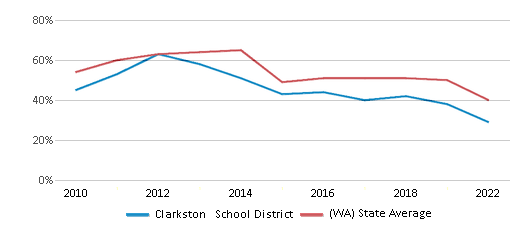
Reading/Language Arts Test Scores (% Proficient)
49%
53%
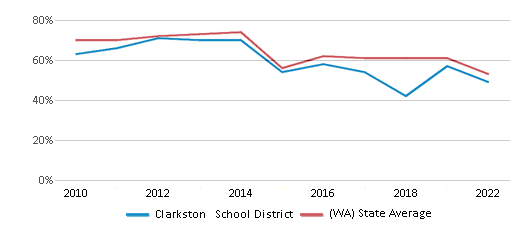
Science Test Scores (% Proficient)
49%
49%
Graduation Rate
73%
84%

Students by Ethnicity:
Diversity Score
0.39
0.71
# American Indian Students
48 Students
2,844 Students
% American Indian Students
2%
1%
# Asian Students
24 Students
25,971 Students
% Asian Students
1%
9%
# Hispanic Students
297 Students
73,094 Students
% Hispanic Students
12%
26%
# Black Students
32 Students
16,473 Students
% Black Students
1%
6%
# White Students
1,964 Students
129,086 Students
% White Students
77%
46%
# Hawaiian Students
6 Students
5,103 Students
% Hawaiian Students
n/a
2%
# Two or more races Students
176 Students
27,229 Students
% of Two or more races Students
7%
10%
Students by Grade:
# Students in PK Grade:
41
23,952
# Students in K Grade:
221
43,573
# Students in 1st Grade:
147
42,048
# Students in 2nd Grade:
177
43,955
# Students in 3rd Grade:
213
39,809
# Students in 4th Grade:
197
41,098
# Students in 5th Grade:
174
39,252
# Students in 6th Grade:
186
3,085
# Students in 7th Grade:
181
1,010
# Students in 8th Grade:
178
1,067
# Students in 9th Grade:
177
319
# Students in 10th Grade:
214
337
# Students in 11th Grade:
215
333
# Students in 12th Grade:
227
580
# Ungraded Students:
-
-
District Revenue and Spending
The revenue/student of $14,024 in this school district is less than the state median of $18,796. The school district revenue/student has stayed relatively flat over four school years.
The school district's spending/student of $13,578 is less than the state median of $19,246. The school district spending/student has stayed relatively flat over four school years.
Total Revenue
$36 MM
$20,715 MM
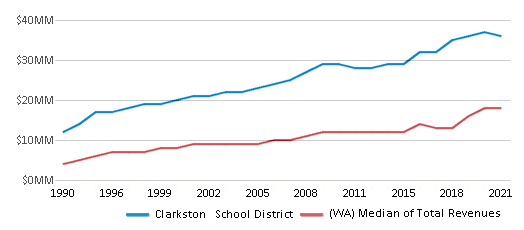
Spending
$35 MM
$21,212 MM
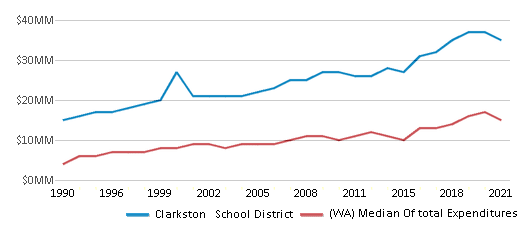
Revenue / Student
$14,024
$18,796
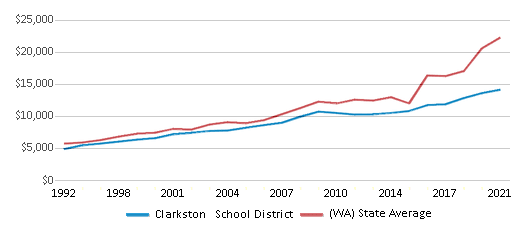
Spending / Student
$13,578
$19,246
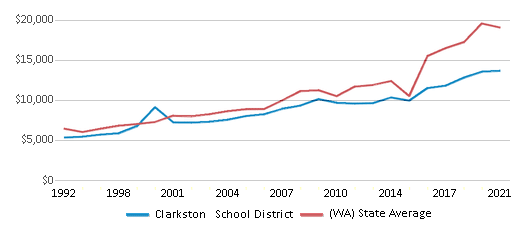
Best Clarkston School District Public Preschools (2025)
School
(Math and Reading Proficiency)
(Math and Reading Proficiency)
Location
Grades
Students
Rank: n/an/a
Special Services
Special Education School
1294 Chestnut St
Clarkston, WA 99403
(509) 758-3309
Clarkston, WA 99403
(509) 758-3309
Grades: PK-12
| 49 students
Recent Articles

What Is A Charter School?
Explore the world of charter schools in this comprehensive guide. Learn about their history, how they operate, and the pros and cons of this educational innovation. Discover key facts about charter schools, including admission policies, demographics, and funding, as well as what to look for when considering a charter school for your child.

10 Reasons Why High School Sports Benefit Students
Discover the 10 compelling reasons why high school sports are beneficial for students. This comprehensive article explores how athletics enhance academic performance, foster personal growth, and develop crucial life skills. From improved fitness and time management to leadership development and community representation, learn why participating in high school sports can be a game-changer for students' overall success and well-being.

February 05, 2025
Understanding the U.S. Department of Education: Structure, Impact, and EvolutionWe explore how the Department of Education shapes American education, from its cabinet-level leadership to its impact on millions of students, written for general audiences seeking clarity on this vital institution.





